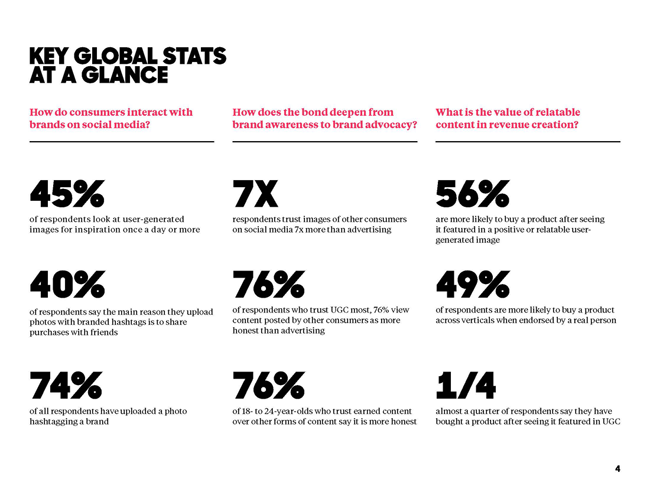UGC's Growing Role in Trust & Transactions

Brands can find great joy (clicks, conversions, conversations) from social media but even greater disappointments when they just can't seem to get their engagement levels, organic reach and return on investment up as high as they'd like. User-generated content (UGC) has proven time and again to be the most trust-worthy form of content (in consumers' eyes) and a new study from Olapic confirms just how much people want to interact with it versus different format types.
Olapic's global study (of 4,500 active social media users between the ages of 16 and 49) indicates that consumers are seven times more likely to trust social media featuring "real people" than content in traditional advertising forms. Similarly, user-generated photos play a critical role across the customer journey, particularly in the U.S. Sixty-five percent of surveyed Americans are interested in looking at social media photos while "pre-shopping"-when consumers begin browsing products-and another 70 percent of Americans express they're more inclined to make a purchase after seeing a relatable consumer post online.
If you're like many marketers, you've heard of UGC's benefits for quite some time but your efforts for encouraging it, collecting it and using it, still need some work. If this sounds familiar, one of the best moves you can make in the new year, is to be consistent with the branded hashtag in use and ensure it's memorable. + Editor's Recommended Reading: Colloborative & Curated Social Media
While the majority (74 percent) of respondents has uploaded a photo and "hashtagged" a brand, they often do so on their own accord (34 percent because they enjoyed the product or service) rather than because they were encouraged to (only 14 percent did so in order to enter a contest). This finding can be frustrating for brands hosting contests and encouraging UGC submission in other ways, as customers are willing to post content on a brand's behalf - when they're happy and not when they're told to do so. To make your branded hashtag work, however, there are some tactics to consider:
- Include the branded hashtag on your website, packaging, social media posts, advertisements so that when a person is ready, they remember what to use
- Monitor the use of the hashtag to respond appropriately
- Ask for permission (or use a service like Olapic) to use the UGC within email, advertisement, social, print and other campaigns to increase the awareness of the branded hashtag
- Keep the hashtag as short as possible while still making sense for the brand
- Make sure to have an active Instagram account as Olapic's research found that (despite Facebook's large audience base) it is the go-to social platform for 18- to 24-year-olds across markets, with 32 percent of them ranking it as number one for interacting with earned images
- Switch out stock photos for UGC images (after permission has been obtained) anywhere it makes sense and include the branded hashtag
- When asking for reviews of your product or service via email, included the branded hashtag so that buyers know there are other ways to share their experience (good or bad as how a brand follows up with negative sentiment can help increase brand awareness and even conversion)
- Brands just getting started with asking for UGC should limit their requests to just one branded hashtag and as they grow can consider adding more specific ones for product launches, etc.
o Olapic reports that when Lancome released its DreamTone serum, the brand encouraged women to post pictures of themselves without makeup; the UGC campaign generating 50 percent of the sales and driving a conversion rate increase of 4 percent for its newly launched product.
UGC is fun for customers to create and beneficial for brands to leverage. Plus, as ad blocking becomes more prevalent in 2017 and organic reach across all networks continues to rapidly decline, it's a strategy that companies can't afford to ignore if they rely on social media for acquiring and retaining customers.
Key UGC Stats

Subscribe to Our Newsletter!
Latest in Social Media











